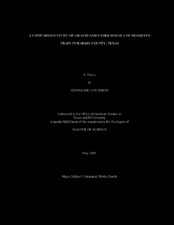| dc.description.abstract | Harris County Mosquito Control Division (HCMCD) is responsible for
surveillance of mosquito species that are vectors of St. Louis Encephalitis (SLE) virus
and West Nile Virus (WNV) within Harris County, Texas, including the Houston
metroplex. The metroplex area has some unique attributes and a vast variety of
environmental habitats that are attractive to vectors of arboviruses and for the
transmission of arboviruses to the human population. Data describing the efficacy of
Gravid (GV) and Underhouse (UH) CO2 traps were analyzed to determine if there is a
significant difference between these two trap types with respect to the number of
mosquitoes and the variety of mosquito species caught. This study was conducted during
the off-peak HCMCD trapping season, to gain information in preparation for a yearround
trapping program utilizing Underhouse CO2 traps for WNV and SLE virus
surveillance.
Adjusting for the week of collection, results suggest that Gravid traps caught
significantly (P = 0.009) more mosquitoes (mean = 23.134 per trap) in the study area
than Underhouse traps (mean = 3.616 per trap), and that Underhouse Traps caught a larger variety of mosquito species (n = 13) than Gravid Traps (n = 11), out of 15 total
different species caught. Gravid and Underhouse traps caught 9 out of 15 of the same
mosquito species during the study period. Culex quinquefasciatus mosquito catches in
Gravid traps and temperature were strongly correlated (Spearman's Correlation
Coefficient = 0.707, P = 0.005).
Geographic Information System spatial analysis indicated clustering of Culex
quinquefasciatus mosquito catches in both Gravid traps, week 9 and 21 (Moran's I =
0.69, P = 0.040 and 0.74, P = 0.021, respectfully ) and Underhouse traps, week 13 and
19 (Moran's I = 0.92, P = 0.002, and 0.89, P = 0.011, respectfully).
It is recommended that Harris County Mosquito Control Division continue to
utilize gravid traps as a primary method of surveillance. Gravid traps (16,194) caught
85% more mosquitoes than Underhouse traps (2,531) over the fourteen week study
period. Their overall success far outweighs the additional materials or labor required for
their use in a successful surveillance program. | en |


